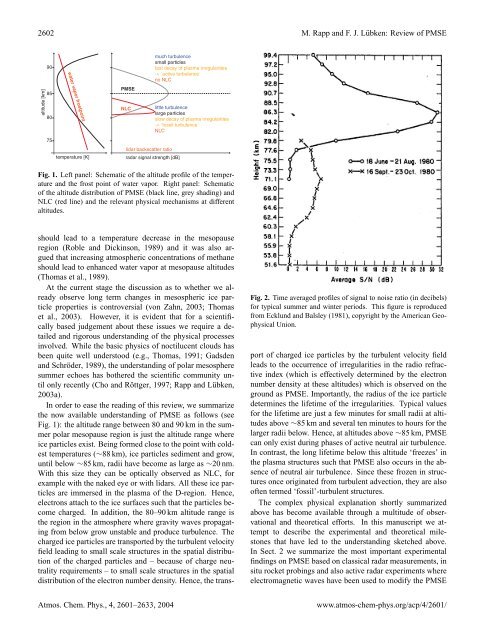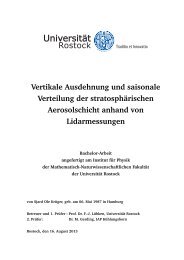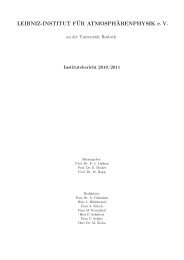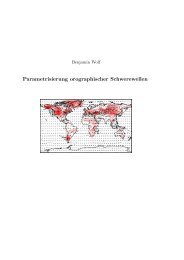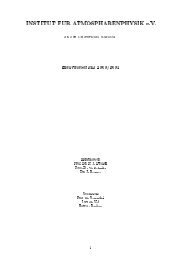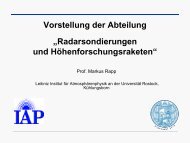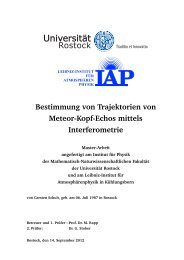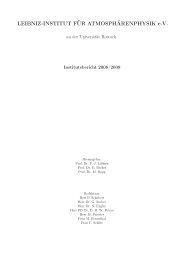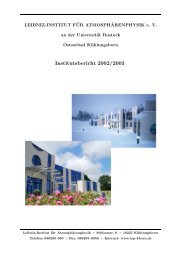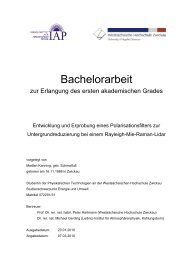Polar mesosphere summer echoes (PMSE): review of ... - HAL
Polar mesosphere summer echoes (PMSE): review of ... - HAL
Polar mesosphere summer echoes (PMSE): review of ... - HAL
Create successful ePaper yourself
Turn your PDF publications into a flip-book with our unique Google optimized e-Paper software.
2602 M. Rapp and F. J. Lübken: Review <strong>of</strong> <strong>PMSE</strong><br />
Fig. 1. Left panel: Schematic <strong>of</strong> the altitude pr<strong>of</strong>ile <strong>of</strong> the temperature<br />
and the frost point <strong>of</strong> water vapor. Right panel: Schematic<br />
<strong>of</strong> the altitude distribution <strong>of</strong> <strong>PMSE</strong> (black line, grey shading) and<br />
NLC (red line) and the relevant physical mechanisms at different<br />
altitudes.<br />
should lead to a temperature decrease in the mesopause<br />
region (Roble and Dickinson, 1989) and it was also argued<br />
that increasing atmospheric concentrations <strong>of</strong> methane<br />
should lead to enhanced water vapor at mesopause altitudes<br />
(Thomas et al., 1989).<br />
At the current stage the discussion as to whether we already<br />
observe long term changes in mesospheric ice particle<br />
properties is controversial (von Zahn, 2003; Thomas<br />
et al., 2003). However, it is evident that for a scientifically<br />
based judgement about these issues we require a detailed<br />
and rigorous understanding <strong>of</strong> the physical processes<br />
involved. While the basic physics <strong>of</strong> noctilucent clouds has<br />
been quite well understood (e.g., Thomas, 1991; Gadsden<br />
and Schröder, 1989), the understanding <strong>of</strong> polar <strong>mesosphere</strong><br />
<strong>summer</strong> <strong>echoes</strong> has bothered the scientific community until<br />
only recently (Cho and Röttger, 1997; Rapp and Lübken,<br />
2003a).<br />
In order to ease the reading <strong>of</strong> this <strong>review</strong>, we summarize<br />
the now available understanding <strong>of</strong> <strong>PMSE</strong> as follows (see<br />
Fig. 1): the altitude range between 80 and 90 km in the <strong>summer</strong><br />
polar mesopause region is just the altitude range where<br />
ice particles exist. Being formed close to the point with coldest<br />
temperatures (∼88 km), ice particles sediment and grow,<br />
until below ∼85 km, radii have become as large as ∼20 nm.<br />
With this size they can be optically observed as NLC, for<br />
example with the naked eye or with lidars. All these ice particles<br />
are immersed in the plasma <strong>of</strong> the D-region. Hence,<br />
electrons attach to the ice surfaces such that the particles become<br />
charged. In addition, the 80–90 km altitude range is<br />
the region in the atmosphere where gravity waves propagating<br />
from below grow unstable and produce turbulence. The<br />
charged ice particles are transported by the turbulent velocity<br />
field leading to small scale structures in the spatial distribution<br />
<strong>of</strong> the charged particles and – because <strong>of</strong> charge neutrality<br />
requirements – to small scale structures in the spatial<br />
distribution <strong>of</strong> the electron number density. Hence, the trans-<br />
Fig. 2. Time averaged pr<strong>of</strong>iles <strong>of</strong> signal to noise ratio (in decibels)<br />
for typical <strong>summer</strong> and winter periods. This figure is reproduced<br />
from Ecklund and Balsley (1981), copyright by the American Geophysical<br />
Union.<br />
port <strong>of</strong> charged ice particles by the turbulent velocity field<br />
leads to the occurrence <strong>of</strong> irregularities in the radio refractive<br />
index (which is effectively determined by the electron<br />
number density at these altitudes) which is observed on the<br />
ground as <strong>PMSE</strong>. Importantly, the radius <strong>of</strong> the ice particle<br />
determines the lifetime <strong>of</strong> the irregularities. Typical values<br />
for the lifetime are just a few minutes for small radii at altitudes<br />
above ∼85 km and several ten minutes to hours for the<br />
larger radii below. Hence, at altitudes above ∼85 km, <strong>PMSE</strong><br />
can only exist during phases <strong>of</strong> active neutral air turbulence.<br />
In contrast, the long lifetime below this altitude ‘freezes’ in<br />
the plasma structures such that <strong>PMSE</strong> also occurs in the absence<br />
<strong>of</strong> neutral air turbulence. Since these frozen in structures<br />
once originated from turbulent advection, they are also<br />
<strong>of</strong>ten termed ‘fossil’-turbulent structures.<br />
The complex physical explanation shortly summarized<br />
above has become available through a multitude <strong>of</strong> observational<br />
and theoretical efforts. In this manuscript we attempt<br />
to describe the experimental and theoretical milestones<br />
that have led to the understanding sketched above.<br />
In Sect. 2 we summarize the most important experimental<br />
findings on <strong>PMSE</strong> based on classical radar measurements, in<br />
situ rocket probings and also active radar experiments where<br />
electromagnetic waves have been used to modify the <strong>PMSE</strong><br />
Atmos. Chem. Phys., 4, 2601–2633, 2004<br />
www.atmos-chem-phys.org/acp/4/2601/


